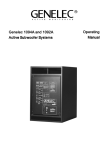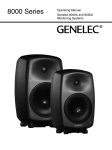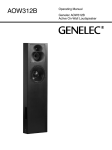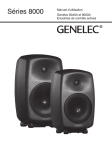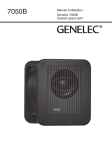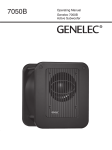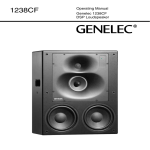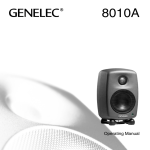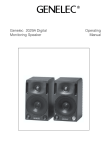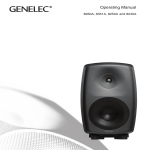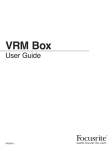Download Genelec 1031A User's Manual
Transcript
1031A Operating Manual Genelec 1031A Monitoring System EC Declaration of Conformity This is to certify that the Genelec Monitoring System 1031A conforms to the following product specifications: Safety: EMC: EN 60065 EN 55013, EN 55020, EN 61000-3-2 and EN 61000 3-3 The product herewith complies with the requirements of The Low Voltage Directive73/23/EEC and EMC Directive 89/336/EEC as amended by Directive 93/68/EEC Signed: Position: Date: Ilpo Martikainen Managing Director 20-Sep-2001 Genelec 1031A Monitoring System System The bi-amplified GENELEC 1031A is a two way active monitoring speaker designed to produce high SPL output, low coloration and broad bandwidth in a small cabinet size. The 1031A is ideal for applications where space is at premium such as Near Field monitoring, mobile vans, broadcast and TV control rooms, surround sound systems and budget and home studios. Designed as an active speaker, the 1031A contains drivers, power amplifiers, active crossover filters and protection circuitry. The Directivity Control Waveguide™ (DCW™) technology used provides excellent frequency balance even in difficult acoustic environments. Drivers The low frequencies are reproduced by a 210 mm (8”) bass driver loaded in a 15 liter vented cabinet. The -3 dB point lies at 47 Hz and the frequency response extends down to 43 Hz (-6 dB). The high frequency driver is a 19 mm (3/4”) metal dome. Uniform dispersion control is achieved with the innovative DCW Technology pioneered by Genelec, which also provides perfect phase and delay uniformity at the crossover frequency. Both drivers are magnetically shielded. Crossover The active crossover network consists of two parallel bandpass filters. Acoustically, the filters are complementary and the slopes are 24 dB/octave. The crossover frequency is 2.2 kHz. The active crossover controls (‘treble tilt’, ‘bass tilt’ and ‘bass roll-off’) allow this speaker to be exactly matched to any room environment. Amplifiers The amplifier unit is mounted to the rear of the speaker enclosure on quick release vibration isolators, to ensure rattle free operation and long term reliability. The bass and treble amplifier produce respectively 120 Watts of short term power. The peak output sound pressure level of the 1031A exceeds 120 dB at 1 m. The unit incorporates special circuitry for driver overload and amplifier thermal overload protection. Variable input sensitivity allows for accurate level matching to console output section. Installation Each 1031A monitor is supplied with a mains cable and an operating manual. After unpacking, place the speaker so that its acoustical axis (see figure 2) is aimed towards the listening position. Do not place the speaker in a horizontal position as this may cause acoustical cancellation problems around the crossover frequency. Sufficient cooling for the amplifier must be ensured if the speaker is installed in a restricted space such as a cabinet or integrated into a wall structure. The minimum clearance for the amplifier is 10 centimeters (4") to any object. The space adjacent to the amplifier must either be ventilated or sufficiently large to dissipate heat so that the ambient temperature does not rise above 35 degrees Celsius (95°F). Before connecting up, ensure that the mains switch is off (see figure 4). Check that the mains voltage selector is correctly set (Models sold in Europe have a fixed 230 V setting). Audio input is via a 10 kOhm balanced XLR connector, but unbalanced leads may be used as long as pin 3 is grounded to pin 1 of the XLR (see figure 3). Once the connection has been made, the speakers are ready to be switched on. Setting the input sensitivity The input sensitivity of the speakers can be matched to the output of the mixing console, or other source, by adjusting the input sensitivity control on the rear panel (see figure 4). A small screwdriver is needed for the adjustment. The manufacturer’s default setting for this control is -6 dBu (fully clockwise) which gives an SPL of 100 dB @1m with -6 dBu input level. Note that to get the full output level of 110 dB SPL, an input level of +4dBu is needed in this setting. Setting tone controls The response of the system may also have to be adjusted to match the acoustic environment. The adjustment is done by setting Speaker Mounting Position TREBLE TILT CONTROL TREBLE TILT dB BASS TILT CONTROL BASS ROLL-OFF CONTROL INPUT SENSITIVITY CONTROL INPUT CONNECTOR OFF ON OFF ON OFF ON +2 -2 dB -4 MUTE USING THE TONE CONTROLS BASS TILT dB +2 0 -2 -4 ALL OFF 4kHz ALL OFF 0 -2 -4 -6 20kHz REFER TO THE OPERATING MANUAL FOR SUGGESTED TONE CONTROL SETTINGS. 20Hz 600Hz -2 -4 dB -6 MUTE BASS ROLL-OFF -2 -4 dB -6 -8 +6 +4 +2 dBu 0 -6 -2 -4 dB INPUT SENSITIVITY REQUIRED FOR 100dB SPL@1m. REFER TO OPERATING MANUAL FOR MAXIMUM SPL. FOR ACCURATE OPERATION ONLY ONE SWITCH IN EACH TONE CONTROL GROUP SHOULD BE ON AT A TIME. FOR A FLAT FREE FIELD RESPONSE SET ALL TONE CONTROLS TO OFF. ALL OFF 0 -2 -4 -6 -8 20Hz 100Hz INPUT SENSITIVITY CAL POSITION ALL CONTROLS : OFF INPUT SENSITIVITY : -6dBu 2 Bass tilt Bass roll-off Flat anechoic response None None None Free standing in a damped room None -2 dB None Free standing in a reverberant room None -4 dB -2 dB Near field or console bridge None -4 dB -4 dB In a corner None -4 dB -4 dB Table 1. Suggested tone control settings in some typical situations PIN 1 = GROUND PIN 2 = + INPUT PIN 3 = - INPUT 3 Treble tilt 1 SIGNAL INPUT MAINS VOLTAGE SELECTOR MAINS INPUT 50 / 60 Hz 150 Watts 115 / 230 V GENELECR ˜ MAINS CONNECTOR 1031A BI-AMPLIFIED MONITORING SYSTEM 495 mm MAINS VOLTAGE SELECTOR (WHERE APPLICABLE) MAGNETICALLY SHIELDED f ON MADE IN FINLAND SERIAL NUMBER MAINS SWITCH WARNING Cable ELECTRIC SHOCK HAZARD! IT IS FORBIDDEN TO UNDO ANY SCREWS ON THIS EQUIPMENT. SERVICING AND ADJUSTMENT MUST ONLY BE CARRIED OUT BY QUALIFIED SERVICE PERSONNEL. NEVER OPERATE THIS EQUIPMENT WITHOUT A PROPER EARTHED MAINS CONNECTION. DISCONNECT THE MAINS INPUT BEFORE REPLACING THE FUSE. RCA (Source) 290 mm THIS EQUIPMENT IS CAPABLE OF PRODUCING SOUND PRESSURE LEVELS IN EXCESS OF 85dB WHICH MAY CAUSE PERMANENT HEARING DAMAGE. 29 0m m ENSURE THAT THE CORRECT VOLTAGE AND APPROPRIATE FUSE ARE SELECTED BEFORE CONNECTING TO THE MAINS SUPPLY. Screen XLR (Speaker) 320 mm Figure 1. Amplifier panel layout of the 1031A the three tone control switch groups ‘treble tilt’, ‘bass tilt’ and ‘bass roll-off ’ on the rear panel of the amplifier. The factory settings for these controls are ‘All Off ’ to give a flat anechoic response. See Table 1 for suggested tone control settings. Figure 5 shows the effect of the controls on the anechoic response. Always start adjustment by setting all switches to ‘OFF’ position. Then set only one switch to the ’ON’ position to select the response curve needed. If more than one switch is set to ‘ON’ (within one switch group) the attenuation value is not accurate. Vertical / horizontal mounting The speakers are normally delivered set up for vertical mounting. Horizontal mounting should be avoided due to the increased likelihood of early reflections that degrade the the direct sound. If horizontal mounting is needed the DCW plate may be rotated so that the Genelec logo remains horizontal by removing the four corner screws of the DCW and carefully lifting and turning the DCW. Console top mounting If the 1031A’s are used for near field monitoring, avoid mounting them on the meter bridge of the console. Instead position the speakers slightly behind the console by using floor stands or wall mounts. This prevents the first reflections from the console surface from coloring the sound. Figure 2. Location of the acoustic axis Overload indicators The speaker is provided with two status LED's marked 'OVL' and 'ON'. The green ON-LED when lit indicates that the speaker is ready for use. The red OVL-LED indicates that the amplifier is overloaded or the driver protection circuit is activated. In both cases reduce the signal level so that the LED stops blinking. If the OVL-LED stays on constantly it indicates that the amplifier thermal protection is activated. Let the amplifier cool down and check that the ventilation at the rear side of the speaker is not blocked. There should be a clearance of more than 4" (10cm) between speaker rear and any solid surface. Maintenance No user serviceable parts are to be found within the amplifier unit. Any maintenance or repair of the 1031A unit should only be undertaken by qualified service personnel. Safety considerations Although the 1031A has been designed in accordance with international safety standards, to ensure safe operation and to maintain the instrument under safe operating conditions, the following warnings and cautions must be observed: 1. Servicing and adjustment must only be performed by qualified service personnel. The amplifier’s rear panel must not be opened. Figure 3. RCA to XLR cable 2. Do not use this product with an unearthed mains cable as this may lead to personal injury. 3. To prevent fire or electric shock, do not expose the unit to water or moisture. Do not place any objects filled with liquid, such as vases on the speaker or near it. 4. Note that the amplifier is not completely disconnected from the AC mains service unless the mains power cord is removed from the amplifier or the mains outlet. WARNING! This equipment is capable of producing sound pressure levels in excess of 85 dB, which may cause permanent hearing damage. Accessories Protective grille Wall mount Floor stand Order code 1031-409 1031-404-V/H* 1031-405-V/H* *State the desired speaker orientation V=vertical or H=horizontal when ordering these accessories. Guarantee This product is supplied with one year guarantee against manufacturing faults or defects that might alter the performance of the 1031A unit. Refer to supplier for full sales and guarantee terms. 1031A Operating Manual AUDIO PRECISION 1031anec LEVEL(dBr) vs FREQ(Hz) 100 07 SEP 93 11:21:58 AUDIO PRECISION 1031anec LEVEL(dBr) vs FREQ(Hz) 07 SEP 93 10:04:11 110 95 105 0° 90 100 15° 85 95 80 90 30° 75 BASS TILT 85 45° 70 80 65 100 75 60 95 70 90 65 20 100 1k 10k 60 20k Figure 4. The upper curve group shows the horizontal directivity characteristics of the 1031A in vertical configuration measured at 1 m. The lower curve is a 1/3 octave band power response, measured in an IEC approved reverberation chamber. SYSTEM SPECIFICATIONS Lower cut-off frequency, -3 dB: Upper cut-off frequency, -3 dB: BASS ROLL-OFF 20 1k 100 Free field frequency response of system: 48 Hz - 22 kHz (± 2 dB) Maximum short term sine wave acoustic output on axis in half space, averaged from 100 Hz to 3 kHz: @ 1m > 110 dB SPL @ 0.5m > 116 dB SPL Maximum long term RMS acoustic output in same conditions with IEC weighted noise (limited by driver unit protection circuit): @ 1m > 101 dB SPL @ 0.5m > 107 dB SPL Maximum peak acoustic output per pair above console top, @ 1 m from the engineer with music material: > 120 dB Input connector XLR female: Input impedance: 10k 20k Figure 5. The curves show the effect of the bass tilt, treble tilt and bass roll-off controls on the free field response. AMPLIFIER SECTION CROSSOVER SECTION < 47 Hz > 22 kHz TREBLE TILT pin 1 gnd pin 2 + pin 3 - 10 kOhm balanced Bass amplifier short term output power with a 8 Ohm load: 120 W Treble amplifier short term output power with an 8 Ohm load: 120 W Input level for 100 dB SPL output @ 1m: variable from +6 to -6 dBu Long term output power is limited by driver unit protection circuitry. Input level for maximum short term sine wave output of 110 dB SPL @ 1m: variable from +16 to +4 dBu Amplifier system distortion at nominal output: THD < 0.05% SMPTE-IM < 0.05% CCIF-IM < 0.05% DIM 100 < 0.05% Subsonic filter below 45 Hz : Ultrasonic filter above 25 kHz: 18 dB/octave 12 dB/octave Crossover frequency, Bass/Treble: Crossover acoustical slopes: 2.2 kHz 24 dB/octave Signal to Noise ratio, referred to full output: Bass > 100 dB Treble > 100 dB Treble tilt control operating range in 2 dB steps: from +2 to -4 dB & MUTE Mains voltage: Self generated noise level in free field @ 1m on axis: < 10 dB (A-weighted) Bass roll-off control operating range in 2 dB steps: from 0 to -8 dB @ 40 Hz Voltage operating range: ±10% Harmonic distortion at 90 dB SPL @ 1m on axis: Freq: 50...100 Hz < 3% > 100 Hz < 0.5% Bass tilt control operating range in 2 dB steps: from 0 to -6 dB @ 80 Hz & MUTE Power consumption: Idle Full output 30 VA 160 VA Drivers: The 'CAL' position is with all tone controls set to 'off' and the input sensitivity control to maximum (fully clockwise). Bass 210 mm (8") cone Treble 19 mm (3/4") metal dome Both drivers are magnetically shielded. 230, 100/200 or 115/230V according to region Weight: 12,7 kg (28 lb) Dimensions: Height 393 mm (15 1/2") Width 250 mm ( 9 7/8") Depth 290 mm (11 7/16") www.genelec.com Genelec Document D1031AR001 Copyright Genelec Oy 6.2003. All data subject to change without prior notice International enquiries: In the U.S. please contact: In China please contact: Genelec, Olvitie 5 Genelec, Inc., 7 Tech Circle Genelec China Representative Office FIN-74100, Iisalmi, Finland Natick, MA 01760, USA Soho New Town, 88 Jianguo Road Phone +358 17 83881 Phone +1 508 652 0900 D-1504, Chaoyang District Fax +358 17 812 267 Fax +1 508 652 0909 Beijing 100022, China Email [email protected] Email [email protected] Phone +86 10 8580 2180 Fax +86 10 8580 2181




